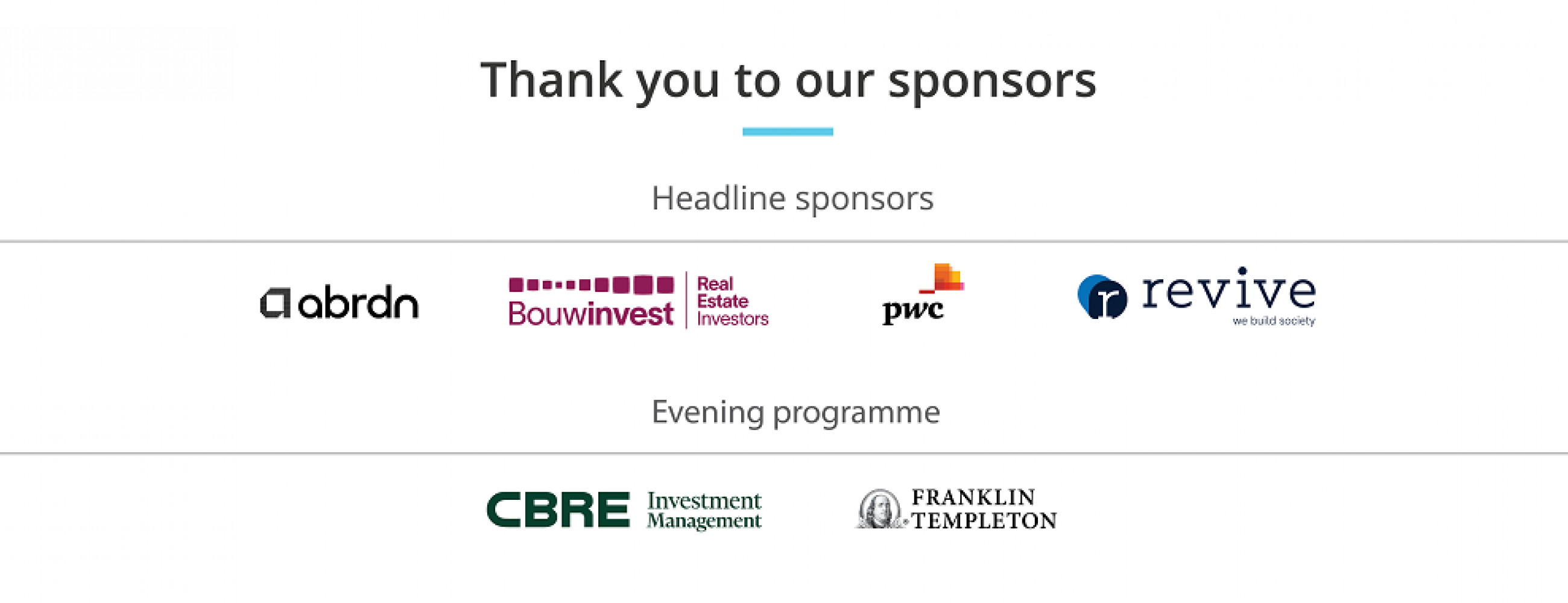ESG Conference 2024: Highlights
The inaugural INREV ESG Conference 2024 took place in the vibrant city of Amsterdam on 26 and 27 June centred around the theme ‘Shaping tomorrow: driving change through ESG’. Though this marked our third annual event dedicated to ESG, it was our first time hosting it as a full-fledged conference, elevating the experience to new heights.
Kicking off with a memorable welcome dinner at Vondelpark, over 170 delegates gathered for an evening that perfectly captured the spirit of the event. The picturesque park provided an idyllic backdrop, complemented by the warm evening sun, setting the stage for an unforgettable BBQ.
Championing progress: leadership strategies for regenerative businesses (Cat Hirst)
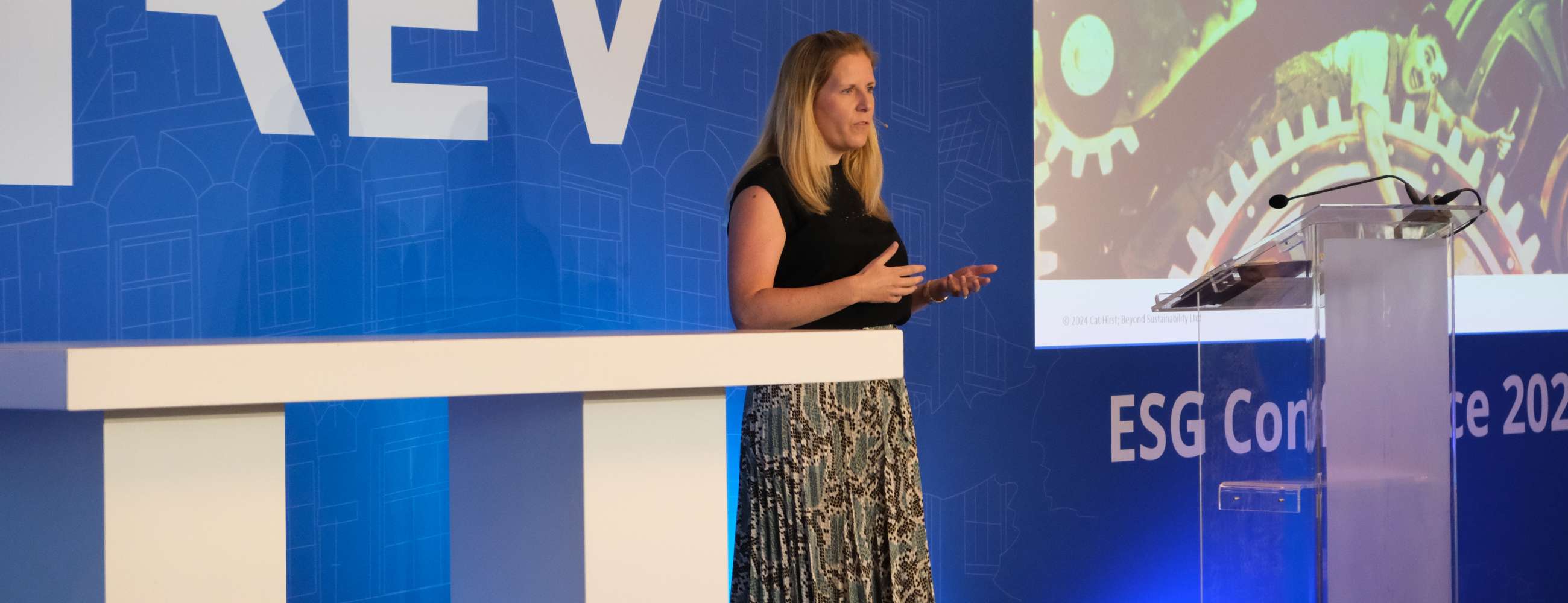
The conference's opening keynote was a powerful address by Cat Hirst, a Sustainability and Regenerative Business Practitioner, who urged us to rethink ESG through a regenerative lens.
Cat captivated the audience with bold statements like "there is only one planet, we continue to live as if we have 2 or 3" and highlighted the urgency: all socio-economic and environmental trends are heading in the wrong direction. From the 9 planetary boundaries that were assessed, we have already crossed 6.
She stressed, ‘We cannot sustain what is already broken—sustainability is not enough.’
She introduced the concept of a ’regenerative business’, one that gives more to the world than it takes. This approach transcends traditional ESG and impact investing. It’s a paradigm shift—a new mindset, culture, design ethos, and business strategy. Instead of viewing businesses as ’well-oiled machines’, we should see them as living systems. It's about nurturing the creative minds within our teams, providing environments where our teams can thrive, not just survive, and empowering them to lead their own journeys and reach their full potential.
Cat wrapped up with eight practical tips: engage, rethink purpose, envision a regenerative future, develop an organisational rationale for regeneration, collaborate, build capacity, embed regenerative principles in decision-making, and experiment boldly.
New build or retrofit? Navigating embodied carbon challenges (Anja, Juliette and Aneta)

The second session of the day tackled the pressing issue of embodied carbon. The focus shifted from just operational emissions to considering whole-life carbon emissions, promoting a circular economy with zero waste.
Anja Köhler, Head of Sustainability at Edge, kicked off with a compelling presentation. She highlighted that 39% of CO2 emissions stem from the real estate industry, with 11% attributable to embodied carbon. As operational emissions decrease thanks to energy-saving measures and sustainable buildings, the share of embodied carbon will rise.
Anja emphasised the need for both technical and process changes in construction, suggesting three key strategies:
- Digital Twins: track and reuse materials efficiently.
- Circular Economy: design buildings for disassembly.
- Product as a Service: implement take-back schemes, like those for facades.
Following Anja's presentation was a panel discussion moderated by Shuen Chan, featuring Juliette Lefébure, Deputy Head of Responsible Investments Real Estate from AXA IM Alts and Aneta Rusiniak, Director ESG Real Estate at Invesco Real Estate Europe.
Key takeaways included:
- Measurement is crucial: standardise and consistently measure embodied carbon.
- Set targets: even if setting targets is complex, having a number to aim for sparks necessary discussions.
- Act now: developers should conduct whole-life carbon assessments at the asset level without waiting for perfection.
- Challenge and collaborate: tenants should push landlords, and investors should challenge developers. Low carbon efforts benefit from long-term partnerships with shared visions.
- Start immediately: don’t wait for perfect answers—begin taking action now.
Utilising technology to accelerate sustainable real estate (Alex Edds)
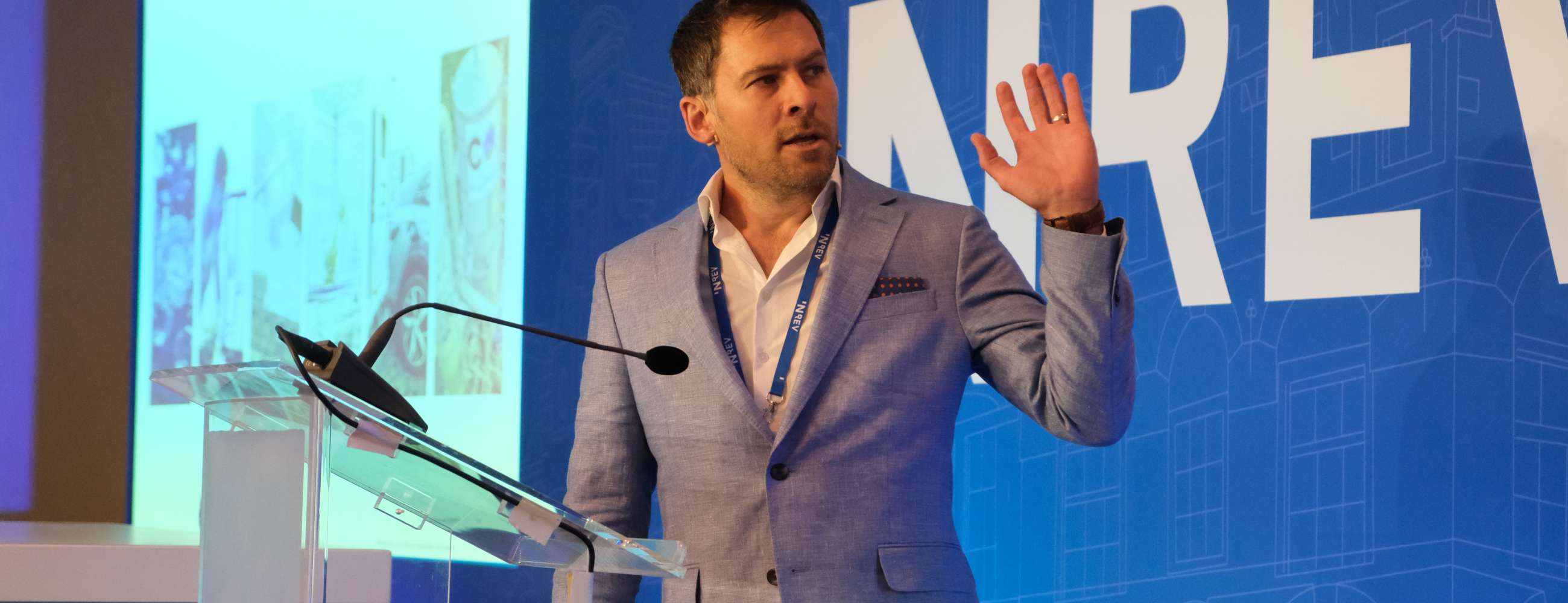
Alex Edds, Head of Sustainability Europe at LaSalle Investment Management emphasised the need to think bolder and bigger, leveraging technology as an enabler for sustainability.
Alex highlighted the necessity for the real estate industry to challenge itself and invest more in research and development (R&D). He stated, ‘Innovation is not R&D; R&D is innovation.’ Currently, the real estate sector invests a mere 1% of budgets in R&D, starkly contrasting with tech giants like Google and Microsoft, who allocate approximately 14% of their annual budgets to R&D.
It is widely accepted that there are still major challenges in scaling up new technologies both at an organisational and asset level. The rapid pace of technological advancement makes it very difficult for the real estate industry to keep up. One promising development is large-scale action models (LAM), which will support the idea of Smart Buildings.
Alex also explained that there are many cases where technology can be incorporated into real estate organisations such as to transform business models, to optimise the building process and to create better digitally enabled buildings.
Additionally, technology can play a crucial role in managing raw data, one of the industry's biggest challenges. Connected data systems that integrate all technologies for an asset, can become essential practice for effective ESG data management.
To harness technology effectively, Alex outlined key considerations:
- Strategy: start small and focus on what you can control
- Implementation: be agile, engender innovation in your team
- Investment & partnerships: select partners that align with your business and challenge them
- Culture and skills: Engage an in-house tech team and upskill your team
Sustainable growth: creating value through responsible investing (Marieke, Hana, Manpreet and Piet)
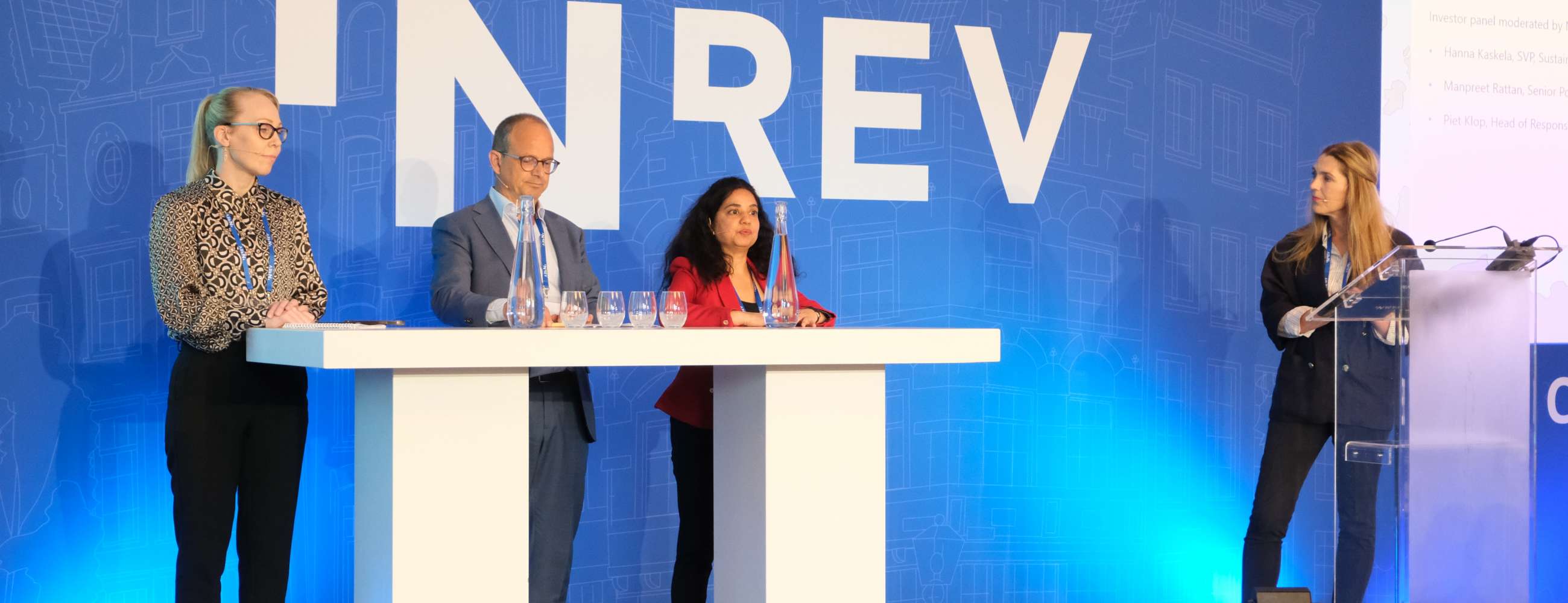
After catching up with each other over lunch, delegates returned to the conference to hear the thoughts of our investors on sustainable investments and what it means to their organisations.
The lively conversation was moderated by Marieke van Kamp, Head of Private Markets, NN Group. Marieke was joined on stage by Hanna Kaskela, SVP, Sustainability & Communications, Varma, Manpreet Rattan, Senior Portfolio Manager at E.ON and Piet Klop, Head of Responsible Investment at PGGM Investments.
Key takeaways included:
- Sustainable investment is a journey, not a policy that you follow
- Sustainability pays, there is an overlap between finance and ESG
- Know what you own, defend it and look at it from three perspectives: risk, return and impact
- It helps to talk with peers, and beware of differences; Nordics and Netherlands are ahead of the curve, Germany is catching up and the UK and the US have different mindsets
- Always think of impact, mitigate any negative impact and avoid investing in ‘stupid stuff’
Green returns: assessing the valuation impact of ESG (Martijn Onderstal)
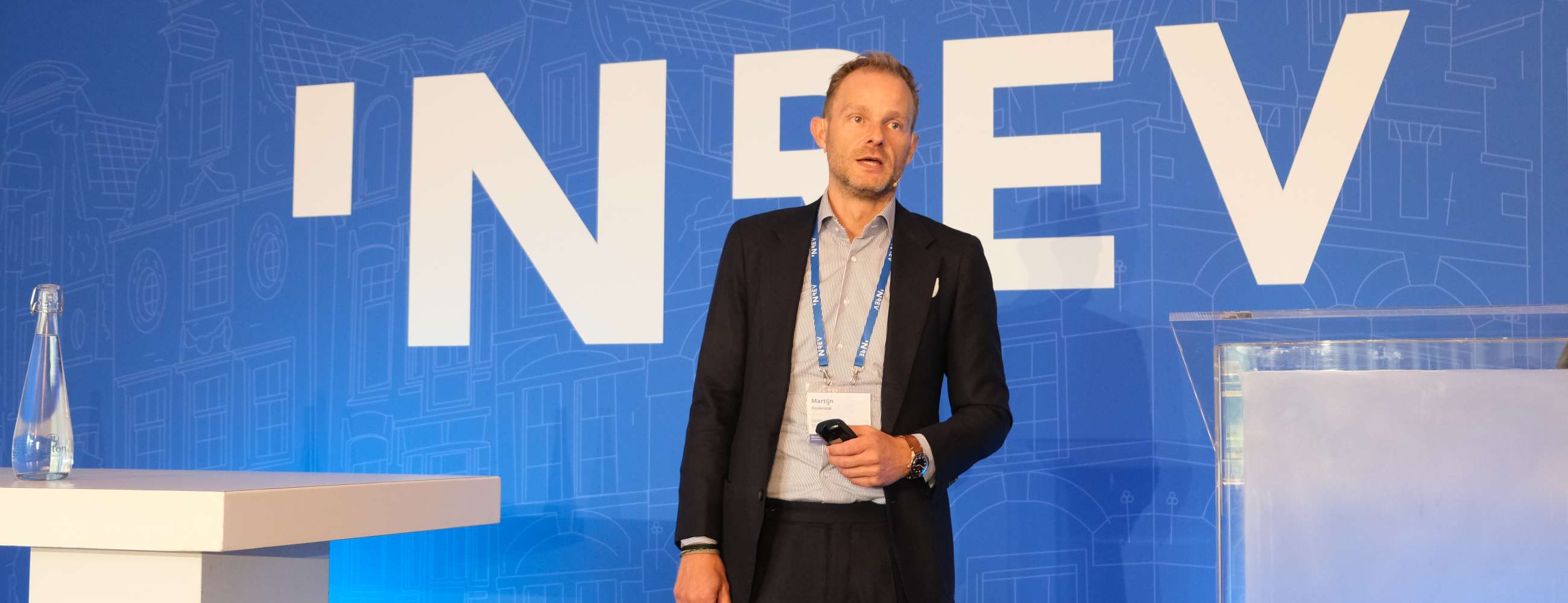
Martijn Onderstal, Head of Valuation at Savills Investment Management, is committed to helping valuers incorporate ESG into their valuations.
Martijn explained that climate-related disasters have not only had a huge impact on the world economy but also on the valuation of assets. He pointed out that EPC labels vary across Europe, leading to a lack of common understanding and there is a lack of CRREM harmonisation across Europe. We need to tackle these issues; key factors influencing valuations include operations, regulations, leases, and disposals.
Data is essential. RICS has created an ESG data list with 12 indicators, overlapping with the INREV ESG SDDS.
Regarding the industry's progress, Martijn candidly stated, ‘It’s a work in progress. It’s not good enough, but it’s the honest answer.’
Profit and purpose: harnessing the power of social impact investing (John and Maya)

In the afternoon it was time to touch on the social side of ESG with two presentations from Maya Savelkoul, Director of Dutch Impact Investments at Bouwinvest and John Levy, Director of Impact at Franklin Real Asset Advisors, followed by a panel discussion.
Maya Savelkou, Bouwinvest
Maya talked about how impact investing sits between philanthropy, doing good, and traditional investing with financial returns. Through their pension fund, Bouwinvest tackles three societal challenges: 1) affordable homes, 2) suitable senior homes and 3) making real estate more sustainable.
Maya explained that Bouwinvest has identified four strategic pillars to tackle these societal challenges:
Affordable: Ensuring rental units are affordable for tenants
Appropriate: Matching the size of the units to the needs of the target tenant groups
Healthy: Promoting social activities to enhance community well-being
Sustainable: Focusing on environmental sustainability
Maya also shared three key lessons that Bouwinvest has learned:
- Social sustainability follows ecological sustainability
- Social impact is measurable
- Impact investing responds to the wishes of stakeholders
John Levy, Franklin Real Asset Advisors
John Levy from Franklin Templeton elaborated on the ‘why, how and what‘ of social impact investing.
He explained that social impact investing aims to demonstrate that capital investments are generating positive societal benefits. Franklin Templeton's approach is built on five main pillars:
- Function enhancement
- Environmental upgrade
- Purpose-driven development
- Stakeholder partnership
- Long term alignment
John highlighted that, beyond the traditional risk-return relationship of modern portfolio theory, Franklin Templeton considers a third dimension: impact. This integrated measurement of social impact is transparently shared with their investors.
Restoring nature’s balance: bold solutions for better climate (Reinier van den Berg)

Reiner van den Berg, the renowned Dutch television weather presenter and climatologist, closed the conference with startling facts and a clear call to action: ‘There is no Planet B; our behaviour needs to change.’
Reiner began by setting the scene, explaining that our ecological footprint is too large, we consume excessive resources, and we significantly contribute to the major climate-related challenges facing the world today. These include overconsumption and waste, loss of biodiversity, and climate change.
He outlined 5 main pillars to prevent climate change:
- More nature & biodiversity
- Saving energy and resources
- Renewable energy generation
- Promotion of circular economy principles
- Introduction of CO2 tax
Reiner concluded with a critical message: we must act now to adhere to the 1.5-degree pathway to combat climate change. Achieving this target is still possible, but it requires the world to be emissions-free by 2050. Failing to meet this target will cause irreversible damage to our planet.
Presentations
A special thanks to our conference moderator, Shuen Chan from LGIM Real Assets who skilfully navigated the day's proceedings, engaging speakers with insightful questions and ensuring everything ran seamlessly.
Photos
Sponsors
